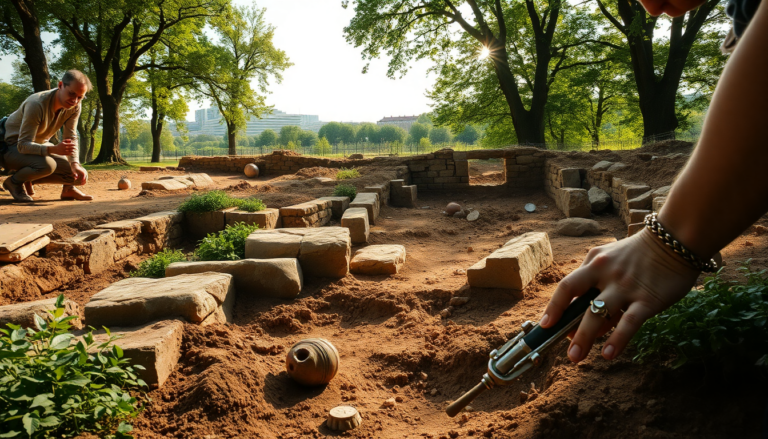Argomenti trattati
When you think of Paris, the first images that likely come to mind are the iconic Eiffel Tower and the bustling cafés lining the streets. But did you know that beneath the vibrant surface of this “City of Lights” lies an ancient world waiting to be uncovered? Welcome to Lutetia, the captivating Gallo-Roman settlement that thrived along the Seine. Recent archaeological discoveries are breathing life into this lost city, revealing a rich tapestry of culture and commerce. Ready to discover the hidden gems of Lutetia, where every stone tells a story? Let’s dive in!
Unearthing the Treasures of Lutetia
Imagine standing in the heart of Paris, specifically the 14th arrondissement, where history has a way of resurfacing. Just over two years ago, construction work at the intersection of Avenue de l’Observatoire and Boulevard de Port-Royal led to the discovery of nearly fifty Gallo-Roman tombs, dating back to the 2nd century AD. This extraordinary find lies within the necropolis of Saint-Jacques, one of the largest funerary complexes of ancient Lutetia.
During Roman times, this necropolis was situated on the southern edge of the city, a reflection of the customs of the era that separated the living from the dead. Spanning more than four hectares, this site opens a window into the past, showcasing one of the best-preserved segments of ancient burial grounds. Today, these tombs stand as poignant reminders of the daily lives, beliefs, and burial rituals of the people who once called this vibrant city home.
Not far from the renowned Notre-Dame Cathedral, you’ll find the Crypte Archéologique de l’Île de la Cité—a true gem in the city’s archaeological crown. Nestled beneath the lively streets of Paris, this crypt offers a fascinating journey through over two millennia of urban history. Opened to the public in 1980 after extensive excavations from 1965 to 1972, it showcases remnants from Lutetia’s early Gallo-Roman settlement, through its medieval evolution, to Haussmann’s transformative 19th-century renovations.
Wandering through the crypt feels like peeling back layers of history, revealing ancient building foundations and cobblestone streets that allow visitors to see Paris from a unique and profound perspective. Isn’t it incredible how history can be so tangible?
The Amphitheater: A Stage for the Ages
Just a stone’s throw away in the lively Latin Quarter lies another treasure: the Roman amphitheater of Lutetia, tucked away at Place des Arènes de Lutèce. Built around the 1st century AD, this well-preserved structure once echoed with applause, dramatic performances, and the intense clashes of gladiators. Today, it serves as a tranquil green space, inviting locals and tourists alike to relax amidst its ancient stone benches.
With a capacity for up to 15,000 spectators, the amphitheater hosted a variety of events, from theatrical performances to gladiatorial contests. Nowadays, you’ll find children playing, students reading, and elders enjoying leisurely strolls, blending the past and present in a delightful way. As you walk along the arena’s sandy floor, can you feel the vibrations of a city that has evolved yet still holds onto fragments of its ancient heritage?
If you’re seeking a place where time feels tangible, the Thermes de Cluny is a must-visit. Located in the Latin Quarter beside the Museum of the Middle Ages, these ancient Gallo-Roman public baths tell the story of a time when Paris was a bustling urban center of the Roman Empire. Built in the 1st century, these baths were more than just places for bathing—they were vibrant hubs for wellness and social interaction.
Today, integrated within the Museum of Cluny, they stand as one of Northern Europe’s best-preserved archaeological sites. Visitors can marvel at the vaulted rooms, swimming pools, and intricate pavements, all testaments to Roman architectural brilliance and their appreciation for functional beauty. How fascinating to think that you’re walking through a space where ancient citizens once gathered!
A Culinary Journey Through Time
As we peel back the layers of Lutetia, it’s essential to reflect on how the culinary traditions of Paris have evolved from these ancient roots. Much like the Roman baths served as a social hub, today’s restaurants and markets echo that communal spirit, inviting us to share meals with friends and family. The palates of Parisians have been shaped by centuries of culinary evolution, influenced by the terroir of the surrounding regions and techniques passed down through generations.
Exploring these archaeological sites connects us not just to the past but also to the vibrant culinary landscape of today. Ingredients sourced from local markets align with sustainable practices, paying homage to the traditions of our ancestors while embracing the modern world. For every dish served in the heart of Paris, there’s a story—one that speaks of ancient customs, the land’s bounty, and the enduring spirit of a city that never forgets its origins.
So, as you wander through the enchanting streets of Paris, take a moment to look beneath the surface. Appreciate the rich tapestry of history that defines this magnificent city. Every step taken in the shadow of Lutetia serves as a reminder that behind every plate lies a legacy waiting to be tasted and celebrated. What delicious stories might you uncover during your next meal in Paris?

